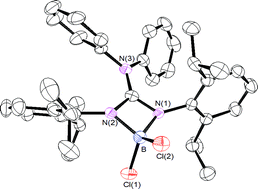Synthesis and structure of two new (guanidinate)boron dichlorides and their attempted conversion to boron(i) derivatives†‡
Abstract
To test the feasibility of the guanidinate architecture for the support of boron(I)

- This article is part of the themed collection: Dalton Discussion 11: The renaissance of main group chemistry

 Please wait while we load your content...
Please wait while we load your content...